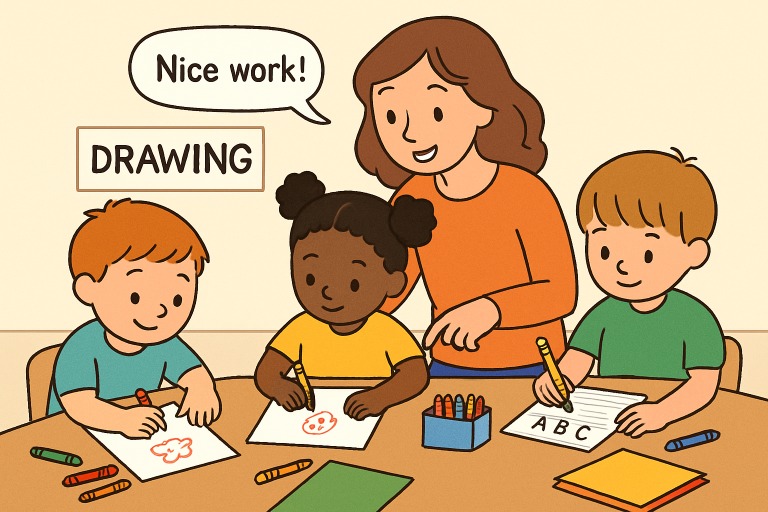Key Takeaways
- Effective writing instruction in kindergarten encourages early literacy and cognitive growth.
- Incorporating play, storytelling, and art can make writing engaging and meaningful for young learners.
- Research supports that strong early writing skills have a positive influence on long-term academic outcomes.
- Caregivers and teachers benefit from practical guidance and evidence-based activities for writing development.
Table of Contents
- Why Kindergarten Writing Matters
- Foundational Skills for Early Writers
- Making Writing Fun Through Playful Activities
- Storytelling as a Gateway to Writing
- Integrating Art and Writing
- Tips for Encouraging Reluctant Writers
- Family Engagement and Support at Home
- Measuring Progress and Celebrating Success
- Resources and Inspiration
- Conclusion
Why Kindergarten Writing Matters
Writing is a foundational skill that unlocks not only literacy but also critical thinking, creativity, and communication. In kindergarten, nurturing writers goes far beyond teaching children to form letters and words. It’s about building a sense of agency, developing language abilities, and encouraging young learners to share their unique ideas. By engaging students with hands-on writing activities for kindergarten, educators set the stage for deeper comprehension and lifelong academic success. From the outset, the best writing environments are those that value experimentation and see mistakes as opportunities for growth. Playful, interactive approaches can make writing accessible to all children, helping them feel empowered and understood.
Foundational Skills for Early Writers
Before young children dive into sentences and stories, they need a strong base of fine motor, phonological awareness, and print concepts. Crucial starting points include practicing the correct pencil grasp, identifying both uppercase and lowercase letters, understanding the connection between sounds and symbols, and forming basic shapes or strokes. Teachers often support these skills through multisensory activities—tracing letters in sand, air-writing, and matching letter cards—that keep lessons engaging and developmentally appropriate.
The National Association for the Education of Young Children (NAEYC) advises that introducing early writing should balance mechanics with open-ended, expressive experiences. Through a mix of direct instruction and child-led exploration, educators help students internalize foundational literacy concepts while still enjoying the process.
Making Writing Fun Through Playful Activities
For kindergartners, writing should feel like a delightful adventure—not a chore. Incorporating imaginative games and creative stations into classroom routines keeps engagement high and supports authentic learning. Writing centers stocked with magnetic letters, stamps, or colorful chalk provide opportunities for kids to explore and experiment. Teachers may organize letter scavenger hunts, encourage collaborative storytelling with puppets, or invite children to write out their own treasure maps. These playful setups motivate children to practice writing in an environment of joy and discovery.
- Letter treasure hunts give children a fun challenge and reinforce recognition skills.
- Word-building with blocks strengthens understanding of sound and letter relationships.
- Collaborative drawing and labeling bring new vocabulary to life in a supportive group setting.
- Role-playing stories and capturing them on paper help bridge the gap between spoken and written language.
Storytelling as a Gateway to Writing
Oral storytelling provides a joyful, low-pressure entry point into writing. When children are encouraged to tell stories aloud, they learn to organize their thoughts, build narratives, and express feelings all key precursors to written composition. Educators and caregivers can ask guiding questions, help children sequence events, and prompt them to draw what happened in their story before attempting any words. Over time, this process helps children view writing as a natural extension of communication and makes the transition from talk to text seamless.
Integrating Art and Writing
Combining drawing and writing opens doors for every kind of learner. Art provides a way to convey meaning even before children have mastered handwriting or spelling. When a child draws a picture and then labels it, or creates a simple comic strip, they’re building vocabulary, sequence, and storytelling skills simultaneously. This multimodal approach can be especially effective for visual and kinesthetic learners, and research has shown it supports retention and engagement for students from diverse backgrounds. Strategies such as illustrated journals, storyboards, or class-created picture books can add variety and ensure that writing remains accessible and exciting for all.
Tips for Encouraging Reluctant Writers
- Praise every attempt: Focusing on effort rather than correctness helps children embrace risk and build confidence. Celebrate spelling approximations, inventive letter formations, and all forms of self-expression.
- Offer choices: Encourage children to select topics or the type of writing—whether it’s a letter, list, or story so they feel invested in the process.
- Model daily writing: Demonstrate authentic uses for writing, such as making grocery lists, sending thank-you notes, or labeling things around the house.
- Allow for free expression: Give children unstructured time for “free writing” where the only rule is to have fun, fostering creativity without constraints.
Family Engagement and Support at Home
Learning to write is a team effort that thrives when schools and families collaborate. Caregivers can reinforce classroom lessons by reading favorite books together, keeping a family journal, or slipping encouraging notes into lunchboxes. Setting aside just 5–10 minutes a day for writing activities signals their importance and allows children to practice skills in a low-pressure setting. These moments offer not just academic support, but meaningful opportunities for connection and shared joy in language.
Measuring Progress and Celebrating Success
Tracking early writing growth doesn’t require formal assessments at this developmental stage. Instead, teachers and families can maintain a portfolio of each child’s writing samples, display finished work on a classroom “story wall,” or invite children to share their stories aloud. Simple checklists, regular feedback, and frequent celebrations for example, a “Writer of the Week” spotlight build children’s pride and encourage ongoing enthusiasm for writing. According to the expert guidance at Reading Rockets, celebrating small milestones and providing opportunities for children to showcase their progress support motivation and build resilience.
Conclusion
Fostering strong writing skills in kindergarten lays the foundation for a lifetime of literacy, communication, and self-expression. Educators and caregivers can make writing meaningful and enjoyable for young learners by combining structured guidance with playful, engaging activities. When families and teachers work together, celebrate progress, and provide consistent opportunities for practice, children gain the confidence to share their voices and ideas. Ultimately, supporting early writers is not just about teaching letters and words—it’s about nurturing curiosity, creativity, and a love of learning that will carry them through their academic journey and beyond.





Leave a Reply